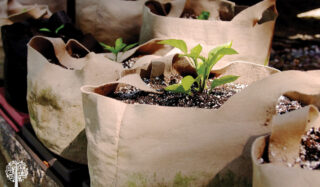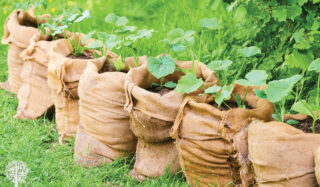We’ve noticed a trend here at Garden Culture: people love growing in buckets, containers, and bags. Some of the articles on the subject are among our most popular, and we’re not surprised. More people live in urban areas, and grow bags and container gardens are perfect for small spaces. So here’s a look at our top five picks for edible crops that do well in containers, buckets, and grow bags.
You’ve got the stuff; now, what vegetables are best for growing bags?
Potatoes
Our blog article on growing potatoes in buckets never seems to get old and is one of our most searched and read topics. Growing potatoes in buckets works incredibly well; I’ve been doing it for years with excellent yields and results. Although tempting, it’s critical not to plant too many seed potatoes in your buckets. The rule of thumb is two in a 5-gallon container, three in a 7-gallon, and five in a 10-gallon. I typically get five to ten new potatoes per seed, sometimes more. Fabric grow bags are great for growing potatoes in bags because you don’t have to worry about drainage, but if growing in buckets or other containers, be sure they have holes for moisture to escape (and if they don’t, drill some). One last thing: mulch your potato buckets well. If the tubers are exposed to sunlight, the potatoes will turn green, and you won’t be able to enjoy your harvest.

Pumpkins
I love growing pumpkins for Halloween and delicious soups, stews, and healthy muffins. I live in an area with a short growing season, so I always select a small variety for my 25-gallon grow bags, such as Cinnamon Girl, Baby Boo, or Sugar Pie. Pumpkins are heavy feeders; be sure to use excellent quality soil enriched with compost. One of the downfalls of grow bag gardens is nutrients and moisture leach out quickly, so be on top of watering and fertilize regularly. I’ve had a lot of success growing this seasonal squash in bags; one year, I had at least a dozen gourds in my Halloween display and then got to enjoy them in some healthy meals throughout November.

Ginger
Sometimes, your geographical location will dictate how you grow, and anyone who wants to grow ginger in Canada or the Northern USA, for example, has no choice but to grow this medicinal crop in a container. All you need to get started is a ginger rhizome that has begun to send out little green shoots. Garden Culture’s president, Eric Coulombe, has written an excellent article in our Mushrooms and Alternative Medicine magazine edition about his ventures growing ginger and turmeric indoors using Autopots. Autopots are a gravity-fed bottom watering system. Yes, you can use conventional containers. However, after experimenting with both, Eric says he’s had faster growth and better yields with his Autopots. After about eight to ten weeks, he harvested three and a half pounds of medicine from his garden, adding it to his home apothecary.
Tomatoes
I enjoy growing many varieties of tomatoes in grow bags and containers. I’ve had a lot of fun growing the Micro-Tom, Orange Hat, and Tiny Tim mini tomato plants in a small pot on my kitchen counter. The yields are impressive, and the plant is a conversation starter! Outdoors, I’ve experimented with several different determinant tomato varieties, including Roma and Campbell’s 33, and they’ve always done incredibly well. I once grew some indeterminate cherry tomatoes in a 25-gallon and didn’t love it. I suggest sticking to the determinant varieties when growing tomatoes in containers or bags. They’re more compact and are a lot tidier than those unruly indeterminates. We’re highlighting our top five crops, but let’s lump peppers and eggplant into the same category as tomatoes; they do fantastic in pots. Remember to water and fertilize more often than you would in-ground gardens, and plant some nasturtiums and marigolds at the base to help with pest control.

Carrots
There’s nothing more delicious than a carrot straight out of the garden –they taste so much better than anything you’ll find at the store. Carrots prefer it if you give them a dedicated space, so it’s best not to plant them with other food crops. If you’ve struggled to grow this root veggie in your raised beds or the ground, it could be because the soil conditions aren’t right. Carrots need loose, sandy soil to do well, and grow bag and container gardening allows you to play with various soil mixes for different crops. Consider a 10-gallon bag for standard-sized carrots. You can try something smaller, but select shorter varieties such as Danvers Half Long, which tolerates shallow soil.